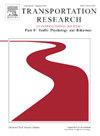Psychosocial predictors of active transport in Australia: Applying an extended theory of planned behaviour
IF 4.4
2区 工程技术
Q1 PSYCHOLOGY, APPLIED
Transportation Research Part F-Traffic Psychology and Behaviour
Pub Date : 2025-07-02
DOI:10.1016/j.trf.2025.05.022
引用次数: 0
Abstract
Active transport (AT), which involves walking or cycling instead of using motorised transport (MT), is underused in Australia. Considering sedentary Australian lifestyles, and the negative impact MT emissions have on climate change, AT offers both health and environmental benefits. Evidence suggests that transport mode choice can be predicted by Theory of Planned Behaviour (TPB) constructs i.e., attitudes, subjective norms and perceived behavioural control (PBC). It is unknown, however, if the TPB extended with descriptive norms, habit and nature relatedness (NR) improves prediction of AT intention and use, and whether MT constructs (the alternate behaviour) are useful predictors. Two online surveys issued one-week apart, measured predictors and subsequent behaviours of adults living in Australia. Participants (N = 294) were aged 18 to 84 years (M = 40.8, SD = 16.0) and predominantly female (n = 199), with 56.5 % completing both surveys. Hierarchical multiple regressions indicated that the standard TPB constructs were significant predictors, explaining over 17 % of the variance in AT intention, after controlling for past behaviour and infrastructure sufficiency. An additional and significant 2.9 % to 3.8 % of AT intention variance was also explained by NR and AT habit. Regarding AT behaviour, AT intention and PBC significantly predicted AT use, accounting for over 46 % of the variance in behaviour. These predictors should therefore be considered when designing strategies to encourage AT uptake. Interventions targeting those higher in NR, or persuasive messaging focusing on subjective norms rather than descriptive norms, may be more effective at increasing Australian AT intentions and use.
澳大利亚主动交通的社会心理预测因素:应用计划行为的扩展理论
主动交通(AT),即步行或骑自行车而不是使用机动交通(MT),在澳大利亚没有得到充分利用。考虑到澳大利亚人久坐不动的生活方式,以及MT排放对气候变化的负面影响,AT提供了健康和环境效益。有证据表明,交通方式选择可以通过计划行为理论(TPB)结构,即态度、主观规范和感知行为控制(PBC)来预测。然而,尚不清楚TPB是否扩展了描述性规范、习惯和自然相关性(NR),从而改善了对AT意图和使用的预测,以及MT结构(替代行为)是否有用的预测因子。两项在线调查相隔一周发布,测量了澳大利亚成年人的预测因素和随后的行为。参与者(N = 294)年龄在18至84岁之间(M = 40.8, SD = 16.0),主要是女性(N = 199), 56.5%的人完成了两项调查。分层多元回归表明,标准TPB结构是显著的预测因子,在控制了过去的行为和基础设施充分性之后,解释了超过17%的AT意图方差。NR和AT习惯也解释了额外且显著的2.9%至3.8%的AT意图差异。关于AT行为,AT意图和PBC显著预测了AT使用,占行为方差的46%以上。因此,在设计鼓励使用人工智能的策略时应考虑这些预测因素。针对NR较高人群的干预措施,或侧重于主观规范而非描述性规范的说服性信息,可能更有效地提高澳大利亚人的at意图和使用。
本文章由计算机程序翻译,如有差异,请以英文原文为准。
求助全文
约1分钟内获得全文
求助全文
来源期刊
CiteScore
7.60
自引率
14.60%
发文量
239
审稿时长
71 days
期刊介绍:
Transportation Research Part F: Traffic Psychology and Behaviour focuses on the behavioural and psychological aspects of traffic and transport. The aim of the journal is to enhance theory development, improve the quality of empirical studies and to stimulate the application of research findings in practice. TRF provides a focus and a means of communication for the considerable amount of research activities that are now being carried out in this field. The journal provides a forum for transportation researchers, psychologists, ergonomists, engineers and policy-makers with an interest in traffic and transport psychology.

 求助内容:
求助内容: 应助结果提醒方式:
应助结果提醒方式:


